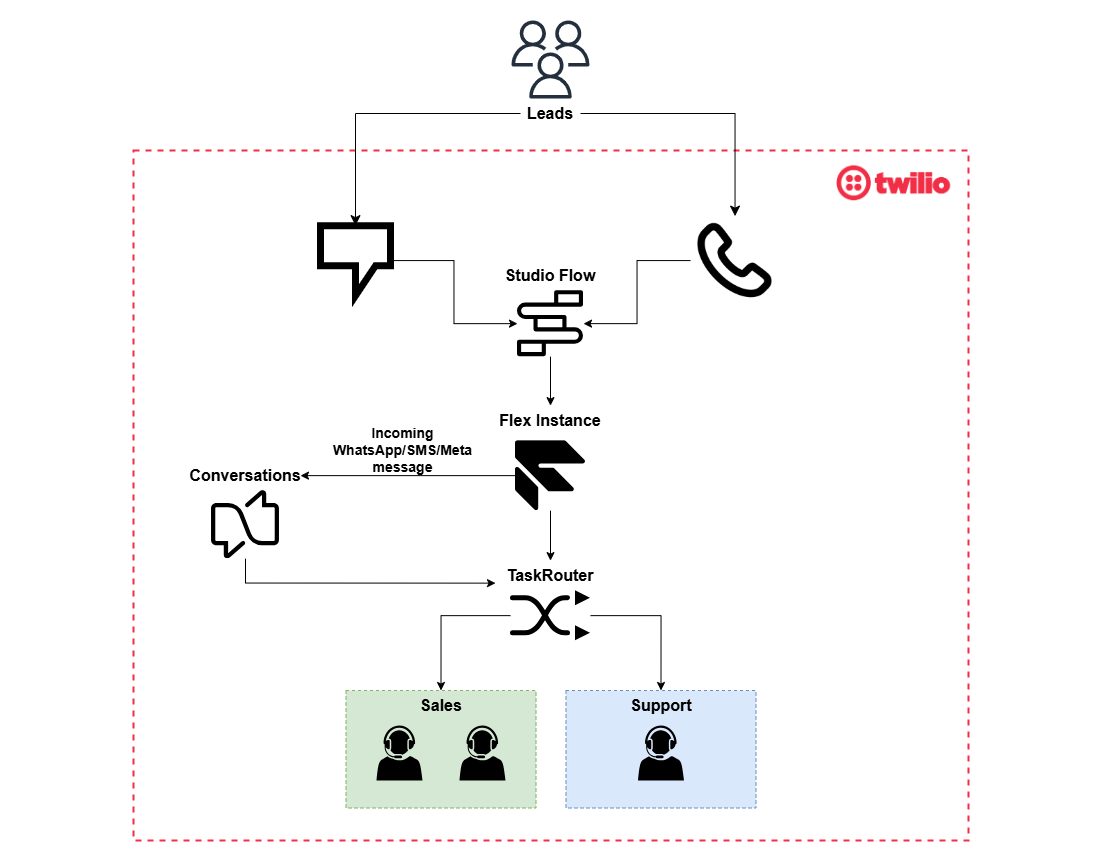
Introduction
A client approached me with a critical need: to build a centralized communication interface within Twilio Flex — one that could manage incoming conversations, route voice calls intelligently, surface historical interactions, and streamline agent workflows. This wasn’t just about improving UI — it was about reducing missed opportunities, boosting response time, and bringing real structure to an unscalable support process.
The Problem
Before implementation, the client struggled with:
- Message chaos: agents had no visibility over ongoing or previous conversations.
- Missed calls: no fallback existed if an agent didn’t answer.
- Poor agent experience: no audible alerts, no centralized data view, no smart prioritization.
- Operational inefficiencies: manual lookups, slow routing, and duplicated tasks for the same contact.
Their core goals:
- Let agents see all past interactions (calls + messages) when a new call or message comes in.
- Create a real-time messaging view inside Flex.
- Forward unanswered calls to voicemail automatically.
- Improve call visibility, even when the browser tab isn't focused.
- Ensure tasks are routed only when necessary — no duplicates.
The Solution
I architected and delivered a full Flex extension and backend call handling system that turned Twilio into a true omnichannel contact center — blending voice, messaging, and agent UX into one cohesive flow. Here's a high-level architectural review of the inbound calls flow

🧩 Core Features Built:
✅ Custom Flex Plugin (Using Twilio Paste)
- Search + Filter View of incoming messages
- "View Conversation" button to pull full history (from Twilio Conversations + external DB)
- Status filtering for unread/replied threads
- Agent productivity dashboard powered by React and Twilio Paste
📞 Smart Call Routing (Studio + Functions)
- Incoming calls hit Twilio Studio → Flex widget
- If unanswered in 20s → redirected via Twilio Functions to a custom voicemail flow
/send-to-voicemailand/voicemail-completeroutes managed audio recording + cleanup- Custom ringtone added to notify agents even if browser tab is not focused
📂 Historical Context on Incoming Call
- When a new task is assigned to an agent, the plugin loads prior call logs and messages automatically
- Flex agent sees full context — reducing talk time and improving resolution accuracy
🔁 TaskRouter Workflow Optimization
- Ensured only one task per contact was active
- If prior task was expired, cancelled, or declined → only then trigger a new task
- Prevented task spam and misrouting
🧠 Agent Config Optimization
- Increased maximum simultaneous tasks per agent to match peak hours
- Allowed for high-throughput contact centers without agent-side performance drop
Tech Stack & Infrastructure
| Component | Role |
|---|---|
| Twilio Flex | Agent UI and plugin host |
| Twilio Paste | Design system for plugin development |
| Twilio Conversations | Message handling layer |
| Twilio Studio | Entry point for voice calls |
| Twilio Functions | Serverless backend for routing logic and voicemail |
| TaskRouter | Task prioritization and agent assignment |
| MySQL | External DB for message archiving |
| React (w/ Hooks) | Flex plugin frontend logic |
Results
- 📞 100% of missed calls captured via voicemail fallback
- 💬 Agents now resolve conversations 30–40% faster thanks to full message/call context
- 🎯 No duplicated tasks, even in bursty environments
- 👂 Custom audio notifications improved call pickup rates noticeably
- 🔍 Managers gained visibility into real-time message load and agent performance
Takeaway
This project was more than a few plugins — it was an overhaul of how the client handled communication at scale.
By bridging Twilio Flex, Conversations, Studio, and TaskRouter with custom logic, I enabled them to operate like a modern contact center without needing additional third-party tools or legacy systems.
👋 Want to build something similar?
I help SaaS companies, startups, and telcos turn Twilio into a fully integrated communications engine — complete with call flows, messaging pipelines, and agent-facing Flex extensions.
Ready to take your project to the next level?
Contact me